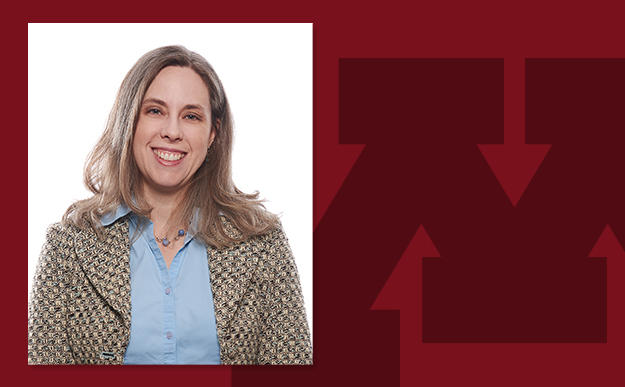PhD student embraces interprofessional studies in her facial pain research

Emily Kahnert, DPT, CCTT, is not a typical PhD student. She calls herself an “unusual combination of a lot of different things here at the University,” saying that she is “blazing some trails in many ways.” Those trails earned her an American Academy of Orofacial Pain Research grant to implement her dissertation research in orofacial pain and TMD.
Kahnert’s journey with the University of Minnesota began when she received her degree in physical therapy fifteen years ago, but she was drawn to dentistry even then.
“I did a clinical experience in the TMD and orofacial pain clinic that caused me to just fall in love with an area I barely knew existed.” As a physical therapist, Kahnert discovered that she could work with TMD patients to diagnose and treat jaw pain in partnership with the orofacial pain clinic.
Kahnert fell in love with this special combination of physical therapy, oral health, and research--but there was not a clear path forward, until her mentors got together and presented her with one. Paula Ludewig, PhD, PT, director of the Division of Physical Therapy at the University of Minnesota, and Donald Nixdorf, DDS, MS, director of the Division of Temporomandibular Joint Disorder and Orofacial Pain, created a PhD option for Kahnert that allowed her to study rehabilitation science, with her clinical work taking place in the TMD and Orofacial Pain Clinic.
“That created the position I am in now and opened up the doors for us to do this collaborative research with departments that has not been done before,” Kahnert explained. This interprofessional endeavor allows Kahnert to gain expertise in physical therapy and apply it to patients who need treatment for orofacial pain.
In the clinic, Kahnert focuses on joint, neck, and head pain, targeting the mechanical restrictions that come from acute and chronic pain conditions. “It is a very natural fit,” she explained. “There is a really clear connection between jaw pain and posture, and in physical therapy, treating posture is what we do.” Kahnert’s work includes joint mobilization, relaxation training, and addressing subconscious habits that aggravate pain.
When she started her program, Kahnert planned to focus on the mechanics of physical therapy in an oral clinic environment. But then the pandemic happened, and like so many other aspects of healthcare, she had to shift to telehealth. Instead of stopping her studies or giving up, she proposed a dissertation study that explores the diagnosis and treatment of orofacial pain by a physical therapist in a non-physical environment.
Thanks to the robust relationship Kahnert has established with clinicians in the orofacial pain team, she was able to create a study that will screen, evaluate, and treat patients in-person and via telehealth to determine the efficacy of telehealth for TMD treatment. It is that study that earned her a grant from the AAOP, for its unique and groundbreaking potential.
“This study has the potential for some very interesting comparison, in ways that would not be possible if I were anywhere else,” she explained. So far, her teletherapy appointments have resulted in surprised, but empowered, patients who feel they are more able to take their treatment into their own hands with the support of verbal cues and excellent communication.
Kahnert is excited to open up possibilities for rehabilitation that reach rural areas that may not otherwise have access to physical therapy treatment. “This went from something temporary to a focus on increased access to care,” she said.
Though the study is still in the conceptual phase, Kahnert is excited to get started and is grateful for the AAOP grant’s support. She sees her study, and her role at the University, as an example of what happens when teams of professionals come together and break down silos.
“This has so much potential to impact our field,” she said. “We have this very dedicated group doing multidisciplinary care at the University of Minnesota, but it has not yet caught on with the rest of the country. Now, people are starting to reach out and realize what is possible. No matter what the results of this study, we will know more about rehabilitative TMD care, and about the future of our impact on patients.”